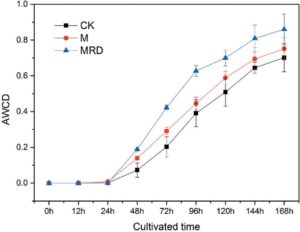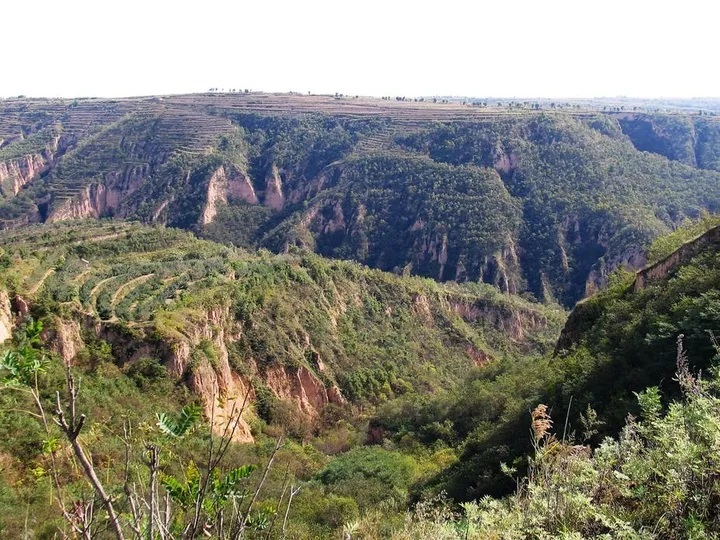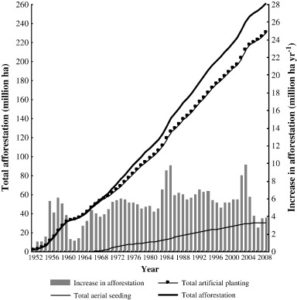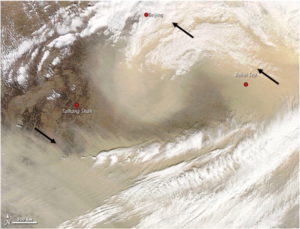Tomatoes, Orchards, and Forests: Studying Reforestation and Remineralization in China
Carbon reduction in China
For China, carbon-reduction efforts remain rooted in reforestation and afforestation efforts, as the country keeps planting trees through to 2025.[4] In addition to these efforts, researchers in the People’s Republic have turned their attention increasingly towards enhanced weathering and rock dust application, studying reforestation and remineralization.
China has decades of experience with major tree planting projects, for example, in 1978 initiating the so-called “Great Green Wall” project (official name: the Three-North Shelter Forest Program), whose goal is to plant 2,800 miles of tree-based wind breaking forest strips to prevent the expansion of the Gobi Desert and provide timber to the local population.
More recently, between 2001 to 2010, China rolled out six ecological restoration projects aimed at tackling soil erosion, flood mitigation and carbon sequestration (among other goals), mainly through preserving forestland and planting new trees over a land area totaling approximately 16 percent of the massive East Asian nation.[1] While there are some project caveats, such as carbon leakage from the efforts themselves (by some estimates up to 20 per cent of sequestration), loss of biodiversity due to limited tree species used,[2] as well as water shortages in sensitive regions, these projects have nonetheless resulted in millions of trees planted and an estimated 132 million metric tons of carbon sequestered per year within the designated land area.[3]
.
Remineralization for reforestation
Enhanced weathering can play a key role in China’s ongoing reforestation and afforestation efforts, according to a 2018 study that shows Chinese forests can play a major role in silicate weathering, with an estimated 7.9 million metric tons of carbon consumption per year only through biomass.[8]
More specifically, the study found that the highest consumption of carbon occurred in subtropical evergreen broad-leaf and mixed forests, which are located primarily in South China, as well as temperate deciduous broad-leaf forests which are primarily located in the country’s northeast.
Factors contributing to increased silicate weathering in these areas include rapid tree growth and forest harvesting. Further, most soils sampled in the regions were acidic, contributing to silicate weathering. Study authors conclude that China’s afforestation and reforestation efforts could consider silicate weathering. They also suggest that China’s forests are good candidates for adding rock powder to enhance silicate weathering to sequester more atmospheric CO2.
More specifically, researchers suggest forests located on flat rations with soil depths greater than two meters are ideal to remineralize, but more studies are needed to determine the best ways to apply rock dust for maximum benefit.[5]
break
Remineralizing apple orchards
A 2020 Chinese study investigated the use of rock-dust amendments on yield and fruit quality of a mature apple orchard, which showed potentially appealing results.[7]

Average well color development (AWCD) in Biolog EcoPlates inoculated with the control apple orchard soil and soils amended with CM and CMRD composts. The inoculated plates were incubated at 25°C for 168 h, and the OD 590 readings were taken every 12 h. The soil treatments are designated as follows: M, soil amended with the CM compost; MRD, soil amended with the CMRD compost; CK, the control soil without compost.
Researchers compared the yield and fruit quality between three conditions: soil with no amendment (control), soil amended with organic compost, and soil with rock-dust-fortified organic compost. In all cases, a chemical fertilizer was added to contribute nitrogen, phosphorus and potassium.
While researchers found that apple trees receiving either organic compost or organic compost fortified with rock dust produced better yield than the control trees (with no amendment) for each of the two years following the compost application, the rock-dust-fortified compost increased yield even more than compost alone — a 187-per-cent increase in yield for rock-dust-fortified compost versus a 127-per-cent increase for compost-only with respect to control trees.
Researchers also discovered increased microbiological activity in the amended soils, which may further enhance mineral weathering and thereby increase the bioavailability of micronutrients to the apple trees.
As impressive as the study results might be, it is important to note the small sample size (35 trees). All of the trees also were more than 15 years old and unhealthy. Further, the orchard soil was already nutrient-poor at the beginning of the study. Therefore, more research is needed before making recommendations for younger, healthier apple orchards in different soil conditions. Nevertheless, the results show promise for improving the condition of such mature orchards.
break
Other agricultural applications
Besides carbon sequestration, rock-dust amendments can be beneficial to agricultural applications more broadly in China. For example, one factor that reduces crop yield is the development of bacterial diseases, such as bacterial wilt. A greenhouse study in 2012 shows tomato plants treated with a soil amendment containing quartz, biotite, potassium feldspar, plagioclase, olivine and rice straw were more resistant to bacterial wilt compared to untreated tomato plants.
Study authors hypothesize that the contributing factors to improved plant health were neutralization of acidic soil and increase in calcium content, as well as decrease in manganese and iron content in rock-dust treated soils.
However, the study was relatively small (36 tomato seedlings per treatment) and was conducted in greenhouse versus field conditions, so further study is required to investigate whether these results can be applied to large-scale farming practices. As such, more research may be required.
break
China’s example
As the world increasingly recognizes the potential for enhanced weathering (see here), China will be a country to keep an eye on for its future developments.
While the Chinese have focused on forest management as a primary means of curbing carbon emissions, research shows enhanced weathering can catalyze these reforestation and afforestation efforts.[8] In addition, recent studies into rock-dust application for agriculture, while small in scale, also provide promising results for crop yield and quality.
It will be exciting to observe what China achieves as forest management, improved agricultural practices and a recognition of the power of rock dust further takes root to the benefit of this nation’s population and planet Earth.
break
Katie Zhuang is a neuroscientist and a software applications engineer based in Switzerland. She became interested in RTE while looking for innovative approaches to fight climate change. She is excited to have learned so much about enhanced weathering and eager to make the research into this topic accessible to everyone.
break
References
- Stanway, D. (2021, August 20). China to step up tree planting campaign to help reach net zero. , Reuters. Retrieved from https://www.reuters.com/world/china/china-step-up-tree-planting-campaign-help-reach-net-zero-2021-08-20/.
- Lu, F., Hu, H., Sun, W., Zhu, J., Liu, G., Zhou, W., Zhang, Q., Shi, P., Liu, X., Wu, X., Zhang, L., Wei, X., Dai, L., Zhang, K., Sun, Y., Xue, S., Zhang, W., Xiong, D., Deng, L., Liu, B., … Yu, G. (2018). Effects of national ecological restoration projects on carbon sequestration in China from 2001 to 2010. Proceedings of the National Academy of Sciences of the United States of America, 115(16), 4039–4044. https://doi.org/10.1073/pnas.1700294115
- Hua, F., Wang, X., Zheng, X., Fisher, B., Wang, L., Zhu, J., Tang, Y., Yu, D. W., & Wilcove, D. S. (2016). Opportunities for biodiversity gains under the world’s largest reforestation programme. Nature communications, 7, 12717. https://doi.org/10.1038/ncomms12717
- Cao, S., Chen, L., Shankman, D., Wang, C., Wang, X., & Zhang, H. (2011). Excessive reliance on afforestation in China’s arid and semi-arid regions: Lessons in ecological restoration. Earth-Science Reviews, 104, 240-245.
- Goll, D.S., Ciais, P., Amann, T. et al. Potential CO2 removal from enhanced weathering by ecosystem responses to powdered rock. Nat. Geosci. 14, 545–549 (2021). https://doi.org/10.1038/s41561-021-00798-x
- Li, JG., Dong, YH. Effect of a rock dust amendment on disease severity of tomato bacterial wilt. Antonie van Leeuwenhoek 103, 11–22 (2013). https://doi.org/10.1007/s10482-012-9781-4
- Li, J., Mavrodi, D.V., & Dong, Y. (2020). Effect of rock dust-amended compost on the soil properties, soil microbial activity, and fruit production in an apple orchard from the Jiangsu province of China. Archives of Agronomy and Soil Science, 67, 1313 – 1326. https://doi.org/10.1080/03650340.2020.1795136
- Song, Z., Liu, H., Strömberg, C. A., Wang, H., Strong, P. J., Yang, X., & Wu, Y. (2018). Contribution of forests to the carbon sink via biologically-mediated silicate weathering: A case study of China. Science of the Total Environment, 615, 1-8.
Support us on Patreon
Thank you for joining us today! Please become a member of RTE and support us on Patreon. Unlike many larger organizations, we work with a team of determined and passionate volunteers to get our message out. We aim to continue to increase the awareness of remineralization to initiate projects across the globe that remineralize soils, grow nutrient dense food, regenerate our forests’ and stabilize the climate – with your help! If you can, please support us on a monthly basis from just $2, rest assured that you are making a big impact every single month in support of our mission. Thank you!











Got something to say?